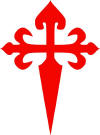|

Santiago de Compostela 2010

The Cross of Santiago

The Tomb of St James
We visited
Santiago de Compostela in April 2010. 2010 is an
Año Santo Jacobeo, a Holy Year as St James' Day, 25th
July, falls on a Sunday this year. This happens every 6, 5, 6
and 11 years. The last one was 2004 and the next will be
2021. In a Jacobeo, the Puerta Santa, the Holy Door,
closest to the Tomb of St James is opened to allow access, and
we were able to visit the Apostle's Tomb and view the
Casket containing his bones during the Pilgrims' Mass at midday.











© Iain Laird
The Baroque Frontage of
the Cathedral and the Praza do Obradoiro, Square of the
Stonemason


© Iain Laird
Plaza de las
Platerias, Square of the Silversmith, entrance to the Cathedral.



© Iain Laird
Puerta Santa, the Holy Door, open only in the Año Santo Jacobeo,
the Holy Year of St James and Praza da Quintana


© Iain Laird
The Cockle Shell, Symbol of Santiago











© Iain Laird
The Tomb of St James
The Tomb of
St
James was discovered in the Year 829. The Apostle James,
brother of Zebedee, brought Christianity to Iberia. On
25th July 44 AD he was interred in a Roman Mausoleum
outside the walls of an old Celtic city. (See
www.catedraldesantiago.com La Tumba Apostólica). In AD 90 St
Atanasio and St Teodoro were interred in the same mausoleum.
Over the following centuries the tom was lost, not least due to
the Invasion of the Moorish Kings Tarik and Muza in 712.
By legend the tomb was revealed to a hermit, Pelayo, who saw a
star falling on the site, giving rise to the name in Latin
"Campus
Stellae" which became Compostela. Bishop Teodomiro uncovered
the Tom and raised the first church on the site in 830 replaced
by a more subtantial church consecrated in 899 and became the
first Cathedral in 1095. (See www.catedraldesantiago.es/ing/webcatedral.html)
It was an important pilgrimage site until the 15th Century. The
completion of the reconquest of Spain, the attention to the
Americas and conflict with England due attention away.
Sir Francis Drake capture part of La Coruña, Peniche and
Vigo in 1589 causing the Apostle's Tomb to be hidden again.
The Tomb was rediscovered again in 1879 and the relics of the
Apostle restored to their place. The Cathedral has been an
object of renewed pilgrimage ever since. For a virtual tour see
the English version of the website
www.catedraldesantiago.es/visita/visitavirtualcatedralING.htm?pcated
The Pórtico de la Gloria

The Romanesque Pórtico de la Gloria (see
www.catedraldesantiago.com El Pórtico de la Gloria ) is very
ornate with beautifully carved figures and decorated Romanesque
Arches).
Palacio de Gelmírez

Alongside the Cathedral is the
Palacio de Gelmírez, the Palace built by Archbishop Gelmírez
in the 12th Century. In the Salón Ceremonial ( in the English
version see
www.catedraldesantiago.es/visita/visitavirtualcubiertasING.htm?pcubie
2nd Floor Ceremonies Room) , the Romanesque Arches start near
the door without decoration for about one third of the length,
then become decorated in the next section and very ornate in the
last section, with the part reserved for the most important
guests being the most ornate, beyond a single column.
The capitals at the base of the arches are intricately carved
with
angels playing instruments, mainly the medieval fiddles and
other figures with food and wine.
The Roof of the Cathedral
The roof is unusual as it is clad
in granite flagstones. Pilgrims were allowed to sleep on
the roof as it was quite comfortable as the stone absorbed and
retained warmth.






















© Iain Laird
The Order of Santiago

The Cross of Santiago
The Order of Santiago is one of the Four Military Orders of
Spain.
The Order of Calatrava was founded in 1158,
The Order of Alcantara in 1176 and
The Order of Montesa in 1317. The Order of Santiago was
founded in 1170 to protect Pilgrims to Santiago de Compostela,
under constant threat from the Moors, who at that time
controlled the Southern half of Iberia, but soon turned its
efforts to the Reconquest of Iberia from the Moors.
The fighting Monks had visions of the Saint with his sword held
high at their head in battle.

Source:
File:Spanish reconquista.gif - Wikipedia, the free encyclopedia
Galician Pipes

© Iain Laird
It is interesting to note the
similarity between
Galician Bagpipes
and the pipes played by the
Angel in Rosslyn Chapel. Unlike
Highland Pipes which have three drones, Galician Pipes
though they may have three drone, but one upright, the bag is
angled down rather than back and the Bass Drone is decorated
with a distinctive fringed frond, rather than cords or banners.
Could William Sinclair, 1st Earl of Caithness, and builder of
the
Collegiate Church of St Matthew, Rosslyn Chapel, have found
inspiration for his Chapel at Santiago? According to
James
Grant's "Scottish Soldiers of Fortune" p. 118-119 Sir Robert
Douglas's Peerage of Scotland recorded that William Sinclair was
a Knight of The Cockle, linking him to Santiago, but Roland
William Saint-Clair's "Saint-Clairs of the Isles" p. 112
says that he was a Knight of the Cockle after the Order of
France, which would be the
Ordre de Saint-Michel
which used the "Coquilles de
Saint-Michel" as its symbol distinct from "Coquilles de
Saint-Jacques".
Links
Catedral de Santiago de Compostela
Catedral de Santiago de Compostela
Camino de Santiago - The pilgrimage routes to Santiago de
Compostela in pictures
Camino de Santiago de Compostela Pilgrimage - Way of St James
Santiago de Compostela
University of Santiago de Compostela
Santiago de Compostela - SantiagoTurismo.com
An Extensive Guide to Camino de Santiago -
10Adventures
Photographs © Iain
Laird 2010-2021
|